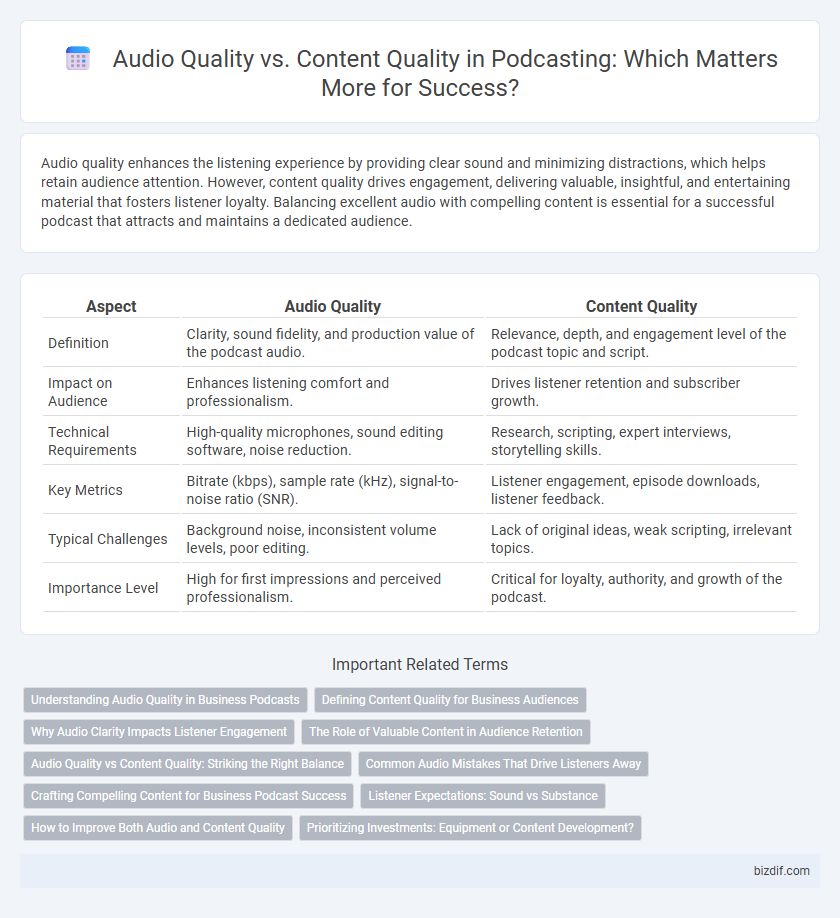Audio quality enhances the listening experience by providing clear sound and minimizing distractions, which helps retain audience attention. However, content quality drives engagement, delivering valuable, insightful, and entertaining material that fosters listener loyalty. Balancing excellent audio with compelling content is essential for a successful podcast that attracts and maintains a dedicated audience.
Table of Comparison
| Aspect | Audio Quality | Content Quality |
|---|---|---|
| Definition | Clarity, sound fidelity, and production value of the podcast audio. | Relevance, depth, and engagement level of the podcast topic and script. |
| Impact on Audience | Enhances listening comfort and professionalism. | Drives listener retention and subscriber growth. |
| Technical Requirements | High-quality microphones, sound editing software, noise reduction. | Research, scripting, expert interviews, storytelling skills. |
| Key Metrics | Bitrate (kbps), sample rate (kHz), signal-to-noise ratio (SNR). | Listener engagement, episode downloads, listener feedback. |
| Typical Challenges | Background noise, inconsistent volume levels, poor editing. | Lack of original ideas, weak scripting, irrelevant topics. |
| Importance Level | High for first impressions and perceived professionalism. | Critical for loyalty, authority, and growth of the podcast. |
Understanding Audio Quality in Business Podcasts
High audio quality in business podcasts enhances listener engagement by ensuring clear speech, minimizing background noise, and providing consistent volume levels. Poor audio quality can distract audiences, undermining the credibility and professionalism of the content, regardless of its value. Investing in quality microphones, sound editing software, and acoustic treatment significantly improves the listener experience and supports effective communication of business insights.
Defining Content Quality for Business Audiences
Content quality for business podcast audiences encompasses relevance, clarity, and actionable insights that address industry challenges and trends. Superior content drives listener engagement by delivering expert analysis, practical advice, and data-driven narratives tailored to decision-makers and professionals. High-quality audio enhances the delivery but cannot compensate for content lacking depth, accuracy, or strategic value in the business context.
Why Audio Clarity Impacts Listener Engagement
Audio clarity significantly impacts listener engagement by enhancing comprehension and reducing cognitive load during a podcast. High-quality audio allows listeners to focus on valuable content without distractions caused by background noise or distortion. Clear sound fosters a more immersive experience, increasing retention rates and encouraging longer listening sessions.
The Role of Valuable Content in Audience Retention
High-quality audio enhances the listener's experience, but valuable content is the critical factor in audience retention for podcasts. Engaging storytelling, insightful information, and relevant topics drive sustained listener interest far more than technical sound perfection. Consistently delivering content that meets the audience's needs fosters loyalty and encourages long-term engagement regardless of minor audio imperfections.
Audio Quality vs Content Quality: Striking the Right Balance
Achieving the right balance between audio quality and content quality in podcasting is crucial for listener engagement and retention. High-fidelity sound enhances clarity and professionalism, but compelling storytelling and valuable content ultimately drive audience loyalty. Podcasters should prioritize consistent audio standards without compromising the depth and relevance of their episodes to maximize impact.
Common Audio Mistakes That Drive Listeners Away
Poor audio quality, such as background noise, inconsistent volume levels, and echo, often distracts listeners and reduces engagement in podcasts. Common audio mistakes like improper mic placement, lack of soundproofing, and failure to normalize audio levels can make professional content difficult to enjoy. Prioritizing clear, balanced audio enhances the listener experience and ensures valuable content retains audience attention throughout the episode.
Crafting Compelling Content for Business Podcast Success
High-quality audio enhances listener experience but cannot compensate for weak content in business podcasts. Crafting compelling narratives and delivering valuable insights build audience trust and drive engagement more effectively. Prioritizing content depth ensures sustainable growth and a loyal listener base over simply investing in audio equipment.
Listener Expectations: Sound vs Substance
Listeners prioritize clear audio quality to engage fully without distractions, but content quality ultimately drives long-term retention and loyalty. High-fidelity sound enhances the immersive experience, while insightful, well-researched topics satisfy audience curiosity and build trust. Balancing crisp audio production with compelling storytelling meets listener expectations for both sound and substance in successful podcasts.
How to Improve Both Audio and Content Quality
Optimizing podcast success requires balancing high audio fidelity with compelling content to maintain listener engagement. Employ professional-grade microphones and soundproof recording environments to minimize background noise and enhance clarity. Simultaneously, invest in thorough research, structured scripting, and dynamic storytelling to elevate content quality and deliver meaningful value to your audience.
Prioritizing Investments: Equipment or Content Development?
Investing in high-quality microphones and soundproofing enhances audio clarity, creating a professional listening experience that attracts and retains audiences. However, compelling content development drives listener engagement and loyalty, proving more sustainable for long-term podcast growth. Striking a balance by initially prioritizing well-crafted content while upgrading equipment progressively maximizes both production value and audience satisfaction.
Audio Quality vs Content Quality Infographic

 bizdif.com
bizdif.com